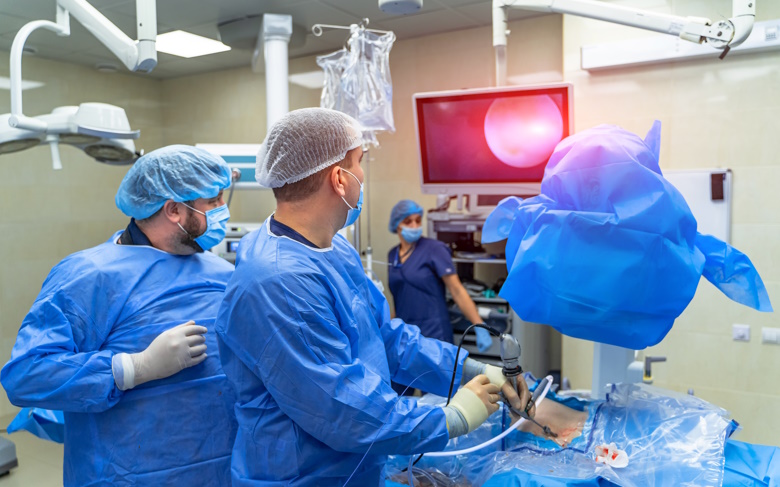Introduction to Laparoscopic Nephrectomy
In the realm of urology, laparoscopic nephrectomy stands as a pioneering procedure that has revolutionized the approach to kidney removal. In this comprehensive guide, we embark on an illuminating journey through the world of laparoscopic nephrectomy, unveiling its rich history, manifold advantages, precise indications, intricate surgical techniques, and the cutting-edge innovations that have propelled it to the forefront of modern urological practice.
What is Laparoscopic Nephrectomy?
Laparoscopic nephrectomy represents a marvel of medical science—a minimally invasive surgical technique designed for the purpose of kidney removal. This transformative procedure involves the utilisation of small incisions and specialised instruments, which work in harmony to execute the intricate task of kidney removal. Patients who undergo laparoscopic nephrectomy stand to gain numerous benefits over traditional open surgery, making it a procedure worth exploring in-depth.
History and Development of Laparoscopic Kidney Removal
To truly appreciate the significance of laparoscopic nephrectomy, one must journey through its remarkable evolution. From its tentative beginnings to the highly sophisticated techniques and state-of-the-art technologies employed today, the history of this procedure is punctuated by pivotal milestones that have redefined the landscape of urology. We invite you to explore the fascinating chronicle of its development, which reflects the relentless pursuit of perfection in urological care.
Advantages of Minimally Invasive Nephrectomy
Minimally invasive nephrectomy means a way to remove a kidney that doesn’t involve big cuts or a lot of surgery. It’s like a more gentle way of doing it. Here’s why it’s a good thing:
Less Pain: When you have minimally invasive nephrectomy, you usually have less pain afterward. It’s like having a smaller ache instead of a big one.
Faster Recovery: You get better more quickly. Imagine getting back to your normal activities faster, like going back to work or enjoying your favorite hobbies.
Shorter Hospital Stay: You don’t have to stay in the hospital for as long. It’s like a shorter visit, and you can go back home sooner.
Smaller Scars: Instead of a big, noticeable scar, you have smaller ones that are not as easy to see. It’s like having tiny marks instead of a big mark on your body.
So, when doctors use this minimally invasive way to remove a kidney, it’s good for you because you have less pain, recover faster, spend less time in the hospital, and don’t have big scars. It’s a kinder way to take care of your health.
Indications for Laparoscopic Nephrectomy
Laparoscopic nephrectomy is a less invasive way of performing kidney removal surgery. This method might be suggested by your doctor for a number of reasons:
Kidney Cancer: If someone has kidney cancer, this technique might be used depending on the specifics of the cancer.
Non-working Kidney: Sometimes a kidney stops working and can cause issues like pain or infections. In such cases, removing it through this method might be considered.
Kidney Donation: For those generous individuals who choose to donate a kidney to someone in need, this method can be used to remove the kidney.
Large Kidney Stones: In some instances, big stones in the kidney might not be treatable by usual methods. Surgery might be the next option.
Kidney with Many Cysts: There’s a genetic condition where a person’s kidney can have lots of cysts, which can lead to the kidney not working properly. In such cases, removing the affected kidney might be recommended.
Other Kidney Issues: For some other problems affecting the kidney, like chronic infections, this surgical method can be a suitable option.
Always remember, the decision to go for this surgery depends on a person’s specific health situation. It’s crucial to have a detailed discussion with the expert Laproscopic Urologist like Dr Pragnesh Bharpoda at Gujarat Superspeciality Hospital, Vadodara to understand the best approach.
The Laparoscopic Nephrectomy Procedure
Facing a laparoscopic nephrectomy can be a daunting prospect, but understanding what to expect can ease your concerns. Here’s an overview of the procedure, tailored to provide you with useful information as a patient.
Preparation: Before surgery, you’ll receive clear instructions. You may need to fast for a specific period to prepare your body.
Anesthesia: In the operating room, you’ll be given anesthesia, which ensures you won’t feel any pain during the surgery.
Small Incisions: Your surgeon will make a few small incisions in your abdomen, much smaller than those in traditional surgery. These serve as entry points for special tools and a camera.
Exploration: The camera helps guide the surgeon, offering a clear view on a screen as they detach the kidney from surrounding tissues.
Kidney Removal: Once ready, the kidney is either removed through a small incision or a slightly larger one if necessary.
Closing Up: Incisions are closed with stitches or adhesive, which will heal over time and become less visible.
Recovery: After surgery, you’ll be monitored until you wake from anesthesia. Pain management will be provided.
Returning Home: Once alert and stable, you can go home with a designated driver, as you might still feel groggy from anesthesia.
Home Recovery: Your doctor will give you instructions for home recovery, including pain management, infection monitoring, and a gradual return to regular activities.
Remember, your medical team is here to support you. Laparoscopic nephrectomy is designed for a quicker, less painful recovery, ensuring you can return to your normal life sooner. Your health is their top priority.
Comparing Laparoscopic Nephrectomy with Traditional Open Surgery
When it comes to kidney removal, you have choices, and it’s important to understand the differences between laparoscopic nephrectomy and traditional open surgery. Let’s compare these two approaches to help you make an informed decision about your healthcare:
Incisions:
- Laparoscopic Nephrectomy: Small incisions, like tiny keyholes, are made in your abdomen.
- Traditional Open Surgery: A single large incision, like a bigger cut, is made.
Pain:
- Laparoscopic Nephrectomy: Usually less pain after surgery because the incisions are smaller.
- Traditional Open Surgery: Often more post-operative pain due to the larger incision.
Recovery Time:
- Laparoscopic Nephrectomy: Faster recovery; you can return to your regular activities sooner.
- Traditional Open Surgery: Longer recovery; it takes more time to heal fully.
Hospital Stay:
- Laparoscopic Nephrectomy: Shorter hospital stay, usually just a day or two.
- Traditional Open Surgery: Longer hospital stay, typically a few days.
Scarring:
- Laparoscopic Nephrectomy: Smaller, less noticeable scars.
- Traditional Open Surgery: A larger, more noticeable scar.
Risk of Infection:
- Laparoscopic Nephrectomy: Lower risk of infection due to smaller incisions.
- Traditional Open Surgery: Slightly higher risk of infection.
Overall Comfort:
- Laparoscopic Nephrectomy: Generally more comfortable due to reduced pain and smaller scars.
- Traditional Open Surgery: May be less comfortable due to post-operative pain and a larger scar.
It’s important to discuss these options with your healthcare team. While laparoscopic nephrectomy offers many benefits, the choice between the two methods depends on your specific medical situation and personal preferences. Your healthcare provider will help you make the best decision for your health and well-being.
Innovative Techniques and Robotic Assistance in Laparoscopic Nephrectomy
Stay at the forefront of urological advancements with insights into innovative techniques that augment the efficacy of laparoscopic nephrectomy. Explore the integration of robotic assistance, which has elevated precision and outcomes to unprecedented heights. Moreover, we will delve into the nuances of laparoscopic partial nephrectomy, a technique designed to preserve kidney function. Stay informed about the cutting-edge research driving continuous improvements in this dynamic field.
Laparoscopic nephrectomy is an emblematic achievement in urology, offering patients a less invasive yet highly effective solution for kidney removal. At Gujarat Superspeciality Hospital, our dedicated urology team is steadfastly committed to providing state-of-the-art care through the application of these advanced techniques. Should you have any inquiries or wish to schedule a consultation, please do not hesitate to contact us.


